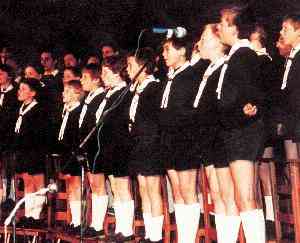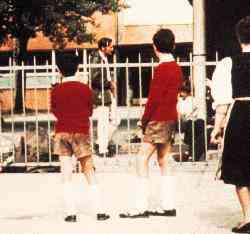ruffled collars were still worn. White knee socks were not just +worn with Fauntleroy suits, were also worn with other outfits such as Buster Brown suits. They were also worn during the summer with white sailor suits. Sock lenth varied somewhat many of these dressy outfits were worn with a kind of 3/4s length. The socks did not come all the way to the knee, but were worn much higher than ankle socks. White knee socks look very dressy to us now, but for dressy occasions dark stockings were considered more appropriate. When The Kennedys went to see the Pope in 1939, for example, Teddy was dressed in a collarless Eton suit--a style becoming increasingly popular for small American boys. He wore his Eton suit with dark long stockings and not white knee socks. Some mothers dressed boys in white kneesocks and strap shoes for play. Red strap shoes were often chosen. These shoes were worn in much the same ways modern boys wear tennis shoes. Eton suits, or suits with collarless jackets that came to be called Eton suits, appeared in the United States during the late 1920s. They were worn with a variety of collar styles. Some were
worn with Eton collars, but this was generally deemed to severe for small boys in America. Eton suits for formal occasions came to be commonly worn with Peter Pan collars. Generally Eton suits were worn with grey, blue or black knee socks. For special events such as weddings they were worn with white knee socks. Other page boy outfits at weddings or formal velvet holiday suits often entailed white knee socks. White knee socks were sometimes worn with ethnic outfits, such as the kilt costimes worn by boys participating in Irish dancing competitions. Unlike Scottish
Highland dancing, the boys doing Irish dance choose solid color kilts in a variety of colors. They also chose solid-colored knee socks instead of the argle socks worn by Higland dancers. The Irish costumes incolved many different colored knee socks. Many are dark colors to contrast with the kilt, but other boys chose bright colors and a few chose white knee socks. Knee socks are now commonly associated in America as girls clothes. Many Catholic and other schools requiring school uniforms have the girls wear knee socks, often white knee socks. We also note boys wearing white kneesocks as part of uniforms or costumes. An example is a Missouri school band in 1923.
Asia
Japan
White knee socks are commonly worn by Japanese elementary children who commonly have short pants school uniforms. Individual schools determine their uniforms and select socks, usually knee socks, of different colors. White kneesocks are chosen by many schools. At Japanese elementary schools the boys and girls generally wear the same color socks. This is different in England, America, New Zealand, and other countries where the girls at many schools wear white knee socks, but the boys colored knee socks. Older Japanesw boys in junior and senior highschool usually wear military style uniforms with long pants. The girls, however, mostly wear sailor suits with white ankel or knee socks.
Korea
Taiwan
Europe
Belgium
We do not yet have much information on Belgian white knee socks. We think that they were worn rather like in France. This seems to have been the case for the French-speaking Waloons. We are less sure about to what extent white knee socks were worb by Flemish-speaking boy.
Bulgaria
European boys choirs until about the 1970s often had short pants uniforms with white knee socks. A Bulgarian
choir wore burgandy velvet short pants suits with white knee socks. Other European choirs had short pants uniforms with white knee socks. Often they were part of ethnic costumes for performances stressing folk music. By the 1980s short pants had become less common and some choirs instead wore knickers.
England
Small boys during the Edwardian period wore white knee socks and stockings with Fauntleroy suits. After World War I small boys continued to wear short and knee-length white socks, often with strap shoes or sandals ("T" strap shoes). English mothers continued to dress small boys in white knee socks as part of dressy outfits. Boys often wore such dressy white knee socks until they were about 6 or 7 years old. Some older boys might wear them, but only as part of costumes for special occasions such as formal weddings. A few pre-prep schools used white ankle socks
as part of their uniform, but I don't know any that used white knee socks. Grey kneesocks were generally used at preparatory schools. Some of the prep schools, however, used white knee socks as part of the games uniform
Generally white knee socks were associated in England with a girls school uniform as many girls' schools and state secondary schools required them as part of the school uniform. As late as the 1980s white knee socks were still being worn by small boys with colored strap shoes. White ankle socks were more common. A young Prince Charles, for example, was usually photographed in white ankle socks. He wore strap shoes and white ankle socks quite extensivly as a small child. I'm not sure if he ever wore white knee socks, I can't seem to find a photograph of him wearing them. Both Prince William and Prince Harry wore them occasionally when they dressed up, but only when they were younger and started going to school. An English reader tells us about his Christmas outftit with white knee socks.

Figure 4.--Many Catholic colleges (secondary schools) in France after World War II had short pants uniforms with white knee socks.
|
|
France
White knee socks have been worn extensively by French boys. I'm not sure about before World War I. I do not recall any French photographs of boys in white knee socks before World War I.
After the war, however, they were quite commonly worn in France. They were worn as part of Fauntleroy velvet suits and other formal outfits. French boys might dress up with a fancy blouse, short pants and white knee socks. Older boys might wear white knee socks with a short pants suit. Many Catholic schools required them as part of the school uniform. As in the United States, French Catholic schools generally insisted on uniforms. Many Catholic schools had uniforms of sweaters, blue shorts, and white knee socks. Blazers were not commonly worn by French school boys. Several conservative Catholic schools continued the short pants and white knee sock uniform in the 1980s when most French school boys were wearing jeans and other casual clothes to school. Some French Boy Scout groups wore white knee socks. The French scouts, like many European scout movements, were and are fragmented along a variety of religious, ethnic, and social limes. I'm not sure just which groups used white knee socks.
 Figure 5.--These brothers wear lederhosen, white knee socks and sandals to school. It was not a school uniform, but mother just decided to dress them
alike.
Figure 5.--These brothers wear lederhosen, white knee socks and sandals to school. It was not a school uniform, but mother just decided to dress them
alike.
|
|
We have begun to develop some information on German hosiery. We do know that white knee socks were worn as part of the regulation dress Hitler Youth uniform. The boys usually wore grey knee socks, but we see many examoles of them dressing up with white knee socks. I believe German boys in after World war I wore white knee socks sailor suits, but less commonly with regular short pants suit. White knee socks seem to be even more common after World War II. They continued to be seen as a kind of drss-up garment. We see quite a number of boys wearing white knee sivks with suits. They were very common for First Communion outfits. They were also widely worn by the boy choirs which became popular aftervthe War. We also see boys wearing white knee socks to school. They were not the most common color, but we do see them. White knee socks began to disappear after German boys began to wear short pants less in the 1970s.
Italy
I have no information on Italy, but believe white knee socks were worn extensively. Italian school children often wore smocks with white knee socks. Private schools, including Catholic schools, appear to have been stricter about requiring white knee socks. State schools might require smocks, but details such as socks and shoes were more likely to be left to the parents. They also wore white knee socks with many dressy outfits. Hopefully an Italian visitor will eventually add to our knowledge here.
Russia
Soviet Young Pioneers in the late-1960s introduced white knee socks as part of the official uniform. Pioneers dod not always wear white knee sicks, bit this was common in the 1960s-70s when dressing up in the Pioner uniform.
Scotland
Scottish boys and men wearing kilts often wear white knee socks. This is particularly common with pipe bands. The white knee socks are usually the heavy atheletic-type of sock. They are usually worn with red garter tabs. They are particularly common with pipe bands.
HBC has acquired many photographs with no accompnying information, including the country and date. This often can be determined by the clothes or various clues such as house styles and cars. But this is not always the case. We have found some images with white knee socks. While we can make some guess in some cases, some we can niot udentify the country with any certainty. We are hoping that HBC readers can provide some insights to help identify the countries involved. This is one of the benefits of the internet.
HBC

Navigate the Boys' Historical Clothing Web Site:
[Return to the Main white kneesock page]
[Introduction]
[Activities]
[Biographies]
[Chronology]
[Cloth and textiles]
[Clothing styles]
[Countries]
[Topics]
[Bibliographies]
[Contributions]
[FAQs]
[Glossaries]
[Images]
[Links]
[Registration]
[Tools]
[Boys' Clothing Home]
Created: 10:37 PM 5/14/2005
Last updated: 11:12 PM 2/6/2015




 Figure 5.--These brothers wear lederhosen, white knee socks and sandals to school. It was not a school uniform, but mother just decided to dress them
alike.
Figure 5.--These brothers wear lederhosen, white knee socks and sandals to school. It was not a school uniform, but mother just decided to dress them
alike.
